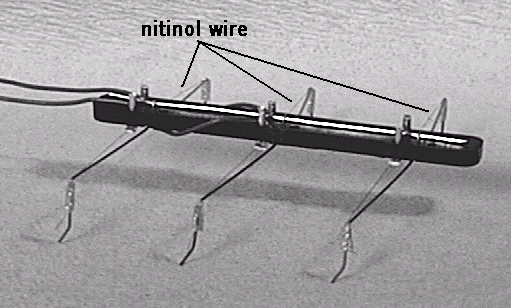








|
|
OverviewIn the early 1990ís, Dr. Jonathan W. Mills searched for an experiment to complement his analog logic research. This search led to the development of a large hexapod robot which he called Sticky. However, the fact that this robot was not very cost effective was a problem. Further development produced a smaller, inexpensive, six-legged robot, called the Stiquito. The robot walks through the use of nitinol wire, specifically Flexinol wire produced by Dynalloy Inc., attached to its legs (see Figure 1 below).
Figure 1: The Stiquito robot with nitinol wire labeled As the
nitinol wire is heated, which is done by applying an electrical
pulse, it contracts.
As the wire cools, it returns to its original position,
causing the Stiquito to walk.
The robot was also used as part of an introductory
engineering course taught at North Carolina State University during
the fall semester of 1996.
NCSU faculty member Dr. James J. Brickley administered the
course along with Dr. Conrad in an attempt to teach students about
engineering design and project implementation.
One possible
procedure for implementing such a course at Penn State is shown in
Figure 2 below.
Figure 2: Timeline for the use of Stiquito robot in a seminar course
[ Results & Conclusions | Future Considerations ] [ Links | Contact Us ] |

